 Tokyo Mirage Sessions ♯FE contains possibly the best idea in all of crossover games, and it is a complete waste.
Tokyo Mirage Sessions ♯FE contains possibly the best idea in all of crossover games, and it is a complete waste.
Tokyo Mirage Sessions ♯FE is a crossover game involving the Shin Megami Tensei and Fire Emblem franchises. However, while both franchises are unmistakably involved, TMS♯FE has much more in common with Shin Megami Tensei’s own spinoff: Persona. And, to be clear, that would the almost spinoff of a spinoff, the post-Persona 3 editions of Persona. Like those games, this is a story predominantly featuring quirky teenagers banding together to fight unknowable, wicked forces while also occasionally hanging out and buying maid costumes at the mall. In this case, the twist is that there is less of a focus on school and “mundane” daily life, as the heroes of the tale are also performers of varying disciplines. Singing! Acting! Whatever it’s called when you’re secretly a Power Ranger! The whole gang is entertaining fans by day, but clearing out monsters by night. … Or… also during the day… I don’t remember if there actually is a “night” in this game…
Regardless! While it’s always interesting to know whether or not your favorite is getting enough hits on Youtube or whatever, the meat and potatoes of TMS♯FE is based on beating back the malevolent mirages in dangerous dungeons. Mirages are essentially demons from another world that prey on the raw fan-power of citizens of our planet, and if these creatures are not defeated, then the whole of the population might not be able to enjoy the finer points of the latest Hatsune Miku release. And, somehow, it is revealed that the whole enterprise of this soul-sucking was supposed to revive an enormous black dragon that could theoretically obliterate the planet, so there are some stakes that go beyond whether some models are inconvenienced by a possessed pervert (it’s… a weird game).
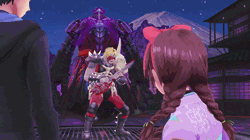 But how do your mundane teenagers save their humdrum lives from this wholly fantastic threat? Simple! They team up with their own, benevolent mirages. These “good” mirages transform into weapons and armor (or at least costumes) for our heroes, and now our leading lady is hurling supernatural blasts from a flying, mechanical pegasus (is noting a pegasus as flying redundant? I suppose it could be a lazy pegasus…). And for anyone familiar with the Persona series, yes, these mirages essentially function like the titular persona “spirits” of that franchise. Everyone gets their own unique mirage, and it is technically this spirit that levels up and learns new skills. Itsuki Aoi can’t really handle himself in a fight against eldritch horrors, but his mirage, Chrom, has got the situation well in hand.
But how do your mundane teenagers save their humdrum lives from this wholly fantastic threat? Simple! They team up with their own, benevolent mirages. These “good” mirages transform into weapons and armor (or at least costumes) for our heroes, and now our leading lady is hurling supernatural blasts from a flying, mechanical pegasus (is noting a pegasus as flying redundant? I suppose it could be a lazy pegasus…). And for anyone familiar with the Persona series, yes, these mirages essentially function like the titular persona “spirits” of that franchise. Everyone gets their own unique mirage, and it is technically this spirit that levels up and learns new skills. Itsuki Aoi can’t really handle himself in a fight against eldritch horrors, but his mirage, Chrom, has got the situation well in hand.
Yes, I said Chrom. Yes, that’s the star of Fire Emblem: Awakening and incidental opponent in Super Smash Bros. Ultimate. He’s a luminary of the Fire Emblem franchise, and he’s the prime mirage of Tokyo Mirage Sessions ♯FE. He is the main character’s mirage, so he’s the headliner of the Fire Emblem characters.
And that’s a good thing. In fact, it’s a brilliant thing! The number one obstacle to anyone starting a JRPG is that it is inevitably going to be “new”. The Final Fantasy franchise is amazing, but right from its first sequel, it has changed dramatically from edition to edition. There are always new characters, new systems, and new menus to navigate with every version. And it seems like the JRPG genre as a whole has followed suit, as we can nary get through a new Dragon Quest or Breath of Fire without a significant shuffling of the deck. Mario might get a graphical upgrade, but he’s always going to be able to jump on goombas, and it doesn’t matter if there’s a water gun strapped to his back this time. Meanwhile, the latest Final Fantasy might introduce its hottest protagonist as Sticky Wicket the Gibbering Thicket, and he may or may not even have a basic “fight” command. Final Fantasy 16 features the ARQ battle system, and you may only attack when the global price of oil has reached a high point. You’ll get used to it!
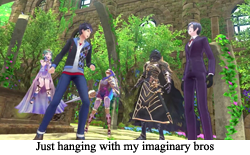 But the benefit of the crossover integral to Tokyo Mirage Sessions ♯FE allows the user to skip that horrid “getting to know you” phase. Most obviously, the battle system of TMS♯FE combines the basic flow of Persona encounters with the nomenclature of both Shin Megami Tensei and Fire Emblem, so if you’re familiar with either franchise, you’re going to recognize the myriad of arrows you’re supposed to rain down on this mounted opponent. And the mirages serve much the same purpose, but to grease the plot in the same way as the battle system. Itsuki Aoi is a completely new character created exclusively for this adventure, and, out of the box, he could be anything. Is he aloof and distant like Squall? Is a he a debonair playboy like Zidane? What kind of protagonist is he? Well, his mirage, his “persona”, is Chrom. And that tells us a lot! This isn’t just a nebulous mythological creature like what we’re used to seeing in Persona: this is a particular, defined hero that has appeared in another game. Chrom is the star of Fire Emblem of Awakening, and there’s an entire game’s worth of story and plotting that will tell us exactly how Chrom would react to a situation. This isn’t to say that Itsuki Aoi is Chrom, but given these characters are inextricably tied together practically from their respective introductions, we do have a general idea how Itsuki and Chrom are similar. We don’t need to wonder what kind of protagonist Itsuki is supposed to be, because we’re quickly given a definitive answer: he’s like Chrom.
But the benefit of the crossover integral to Tokyo Mirage Sessions ♯FE allows the user to skip that horrid “getting to know you” phase. Most obviously, the battle system of TMS♯FE combines the basic flow of Persona encounters with the nomenclature of both Shin Megami Tensei and Fire Emblem, so if you’re familiar with either franchise, you’re going to recognize the myriad of arrows you’re supposed to rain down on this mounted opponent. And the mirages serve much the same purpose, but to grease the plot in the same way as the battle system. Itsuki Aoi is a completely new character created exclusively for this adventure, and, out of the box, he could be anything. Is he aloof and distant like Squall? Is a he a debonair playboy like Zidane? What kind of protagonist is he? Well, his mirage, his “persona”, is Chrom. And that tells us a lot! This isn’t just a nebulous mythological creature like what we’re used to seeing in Persona: this is a particular, defined hero that has appeared in another game. Chrom is the star of Fire Emblem of Awakening, and there’s an entire game’s worth of story and plotting that will tell us exactly how Chrom would react to a situation. This isn’t to say that Itsuki Aoi is Chrom, but given these characters are inextricably tied together practically from their respective introductions, we do have a general idea how Itsuki and Chrom are similar. We don’t need to wonder what kind of protagonist Itsuki is supposed to be, because we’re quickly given a definitive answer: he’s like Chrom.
And this is an amazing way to handle a crossover. You can have your cake and eat it, too! You get to introduce all-new characters with unique motivations and designs, but their immediate association with established characters from another established franchise allows the player to instantaneously identify and, more importantly, identify with the new class. It’s the reason there is always a Link in every Legend of Zelda (he is always strong, but kind), and even the reason Chrom exists in the first place. Back in Fire Emblem Awakening, you were supposed to see “this guy looks like Marth” and immediately assume he is the next heroic lord of the franchise. New character, old archetypes. And using this immediate familiarity in conjunction with a crossover grants players an opportunity to see disparate franchises come together and immediately understand their apparent links.
It’s just kind of a shame that this idea was wasted by relying on the Fire Emblem franchise.
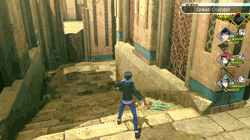 Look, I know I’m biased. As I pointed out back when I first reviewed Fire Emblem: Awakening, I am not someone that has ever been a big fan of the FE franchise. I’m not generally a fan of strategy/tactics based RPGs, and, frankly, the way the franchise introduces a new cast of fifty randos with every sequel is daunting. I don’t have the time or inclination to go down the gargantuan rabbit hole that is the complete 30 year history of Fire Emblem.
Look, I know I’m biased. As I pointed out back when I first reviewed Fire Emblem: Awakening, I am not someone that has ever been a big fan of the FE franchise. I’m not generally a fan of strategy/tactics based RPGs, and, frankly, the way the franchise introduces a new cast of fifty randos with every sequel is daunting. I don’t have the time or inclination to go down the gargantuan rabbit hole that is the complete 30 year history of Fire Emblem.
But, that said, it would be nice if I even could.
Let’s see here… The first Fire Emblem game released in America was in 2004, far from the Japanese 1990 debut. From there, we saw the games featuring Ike on the Gamecube and Wii, but that was likely just because Nintendo was still smarting from the N64 years, and looking for a “Final Fantasy” killer… or at least one or two RPGs it could promote on its latest systems. Despite the Wii’s popularity exceeding certain kinds of bread (screw you, rye), Fire Emblem: Radiant Dawn wasn’t a shining new dawn for the franchise. However, Fire Emblem Awakening, Fates, and Three Houses have been revelations across the board. If my twitter feed is any indication, Lady Edlegard is now the official Queen of Earth. However, that kind of popularity did not apply to Fire Emblem: Shadow Dragon, a Nintendo DS release from 2009. It was a remake of a game that was not released in America, and this remake was released in America with about the same level of hype as Blue Dragon Plus. Remember Blue Dragon Plus? Me neither. But it’s not like half the cast of Tokyo Mirage Sessions ♯FE is based on characters from Blue Dragon Plus…
It’s my own fault for not playing a random DS title from a decade prior, right? If I wanted to see Marth in action, I should have taken the chance back when I could. And I did play Fire Emblem: Awakening, and that game is featured as much as (if not more than!) Fire Emblem: Shadow Dragon. I should recognize everybody from that game!
Except…
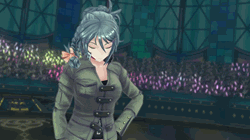 The second good mirage from Fire Emblem: Awakening that is introduced is Tharja. Tharja is a sorceress that is one of the most popular characters to come out of Awakening (apparently #3 in a Japanese poll that I have to assume is part of the national Japanese democratic process). She is a mage that is very shy, but very willing to use her magic and curses to damn anyone that gets in the way of her goals. She is also canonically bisexual, as she will fall in love with the main character regardless of gender. And her outfit is about 90% transparent nylon, so there’s probably a not insignificant portion of her fandom that simply wants to see her use her dark magic in more gratifying ways. In short, Tharja is a popular and unique character in FE: Awakening, so it makes sense she would be revisited for a crossover title.
The second good mirage from Fire Emblem: Awakening that is introduced is Tharja. Tharja is a sorceress that is one of the most popular characters to come out of Awakening (apparently #3 in a Japanese poll that I have to assume is part of the national Japanese democratic process). She is a mage that is very shy, but very willing to use her magic and curses to damn anyone that gets in the way of her goals. She is also canonically bisexual, as she will fall in love with the main character regardless of gender. And her outfit is about 90% transparent nylon, so there’s probably a not insignificant portion of her fandom that simply wants to see her use her dark magic in more gratifying ways. In short, Tharja is a popular and unique character in FE: Awakening, so it makes sense she would be revisited for a crossover title.
And I’d love to tell you more about her, but when I played FE: Awakening, I kinda killed her on our first encounter. Look! I was trying to rescue a queen, and…. It was a bit of a whoopsie, okay? My bad!
Which brings us to the other issue with this Fire Emblem crossover: Fire Emblem is a very variable franchise. You saw it back in the day with permanent death options meaning some support buddies might not live to see the plot past the first chapter, and you see it today with Three Houses and three entirely separate stories dividing everyone’s experiences. Did you choose the Golden Deer route? Well, sorry about that reference to Edlegard being beloved earlier. You probably think she’s a bitch! And even within Fire Emblem: Awakening, you not only have the option of popular party members being killed, but about a third of the cast might not even exist if you don’t get the other 66% to breed like bunnies. Is Morgan your favorite character? Well I missed that dude or dudette, because my Robin knew how to keep it in her pants. There is a war happening, people!
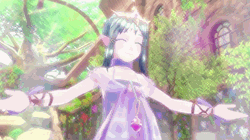 So this is Tokyo Mirage Sessions ♯FE’s greatest strength and most glaring weakness: it relies on a complete familiarity with Fire Emblem. Rather than going the “easy” crossover route of only featuring the most obvious titans of its parent franchise, it features random dudes and ladies from across a few specific titles, and thus requires the player to be unerringly knowledgeable about everything in those games. It takes days to complete a Fire Emblem: Awakening playthrough, and you better have found everything if you want to truly understand the nuances involved in another hours-long JRPG experience. What could have been an excellent introduction to the Fire Emblem world is instead hampered by its own requirement that you already be an expert. It’s a crossover by fans, for fans, and it squanders its supreme strength as a result.
So this is Tokyo Mirage Sessions ♯FE’s greatest strength and most glaring weakness: it relies on a complete familiarity with Fire Emblem. Rather than going the “easy” crossover route of only featuring the most obvious titans of its parent franchise, it features random dudes and ladies from across a few specific titles, and thus requires the player to be unerringly knowledgeable about everything in those games. It takes days to complete a Fire Emblem: Awakening playthrough, and you better have found everything if you want to truly understand the nuances involved in another hours-long JRPG experience. What could have been an excellent introduction to the Fire Emblem world is instead hampered by its own requirement that you already be an expert. It’s a crossover by fans, for fans, and it squanders its supreme strength as a result.
Tokyo Mirage Sessions ♯FE is a great crossover title, but it would be even better if I knew what the hell a “Draug” is supposed to be…
FGC #497.1 Tokyo Mirage Sessions ♯FE
- System: Nintendo WiiU, and now (finally) on the Nintendo Switch. No excuses! Go play it!
- Number of players: Three man party, one man player.
- Just play the gig man: The music is great. I mean, this is a game that is based on half the cast being in the music industry, so the music better be good, but… yeah. It’s good. It’s very easy to see how this game is the secret Persona game before Persona 5’s crazy soundtrack.
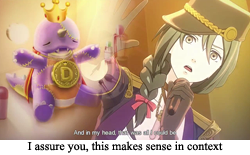 Favorite Character: Ironically enough, it’s Kiria Kurono, the songstress associated with Tharja. While I’m always going to be annoyed when a character is built up as some incredible badass, and then the gameplay reveals she’s just kind of a middling mage (see also Persona 3’s Mitsuru), she also appears to be the only member of the team that actually knows what she’s doing at any given moment. And, yes, her whole “senpai” role seems to be literally designed to be appealing to the average Persona/SMT/FE player (again, see Mitsuru), and her “cool, but secretly cute” personality is obviously engineered to be endearing. But I still fell for it hook, line, and sinker, and I’m not going to over think it. Maybe I’m just happy she could hit that black dragon’s weak points.
Favorite Character: Ironically enough, it’s Kiria Kurono, the songstress associated with Tharja. While I’m always going to be annoyed when a character is built up as some incredible badass, and then the gameplay reveals she’s just kind of a middling mage (see also Persona 3’s Mitsuru), she also appears to be the only member of the team that actually knows what she’s doing at any given moment. And, yes, her whole “senpai” role seems to be literally designed to be appealing to the average Persona/SMT/FE player (again, see Mitsuru), and her “cool, but secretly cute” personality is obviously engineered to be endearing. But I still fell for it hook, line, and sinker, and I’m not going to over think it. Maybe I’m just happy she could hit that black dragon’s weak points.- Is there any other reason you like this game: Oh, I have no idea what you’re talking about.
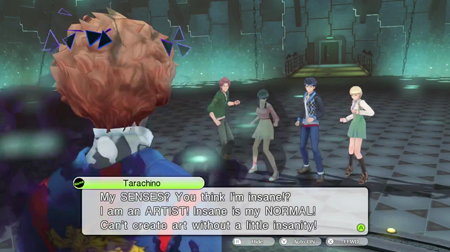
None at all.
- Did you know? Draug is apparently a knight from Shadow Dragon, so that explains why I’ve never heard of the dork. According to the FE wiki, he is shown to have a comradery with two other characters, but this “link” only appeared in official art, and not actual gameplay, in his original games. So, yeah, that sounds like par for the course for the Fire Emblem franchise.
- Would I play again: I’ll answer that shortly, as…
What’s next? We’re sticking to Tokyo Mirage Sessions ♯FE for the moment, as I still want to talk about this game in a non-crossover context. So please tune in next Monday as crossover week is finished, but talking about the same stupid game in a slightly different way is back. Please look forward to it!


[…] Smash Trivia: The appearance of “Marth” in Super Smash Bros. Melee solidified our hero’s name’s translation. Sorry, Mars. However, other Fire Emblem characters have appeared as stickers and trophies in Smash Bros, but later had their names retranslated when their actual games appeared stateside. Shiida was a sticker before we saw Caeda… […]